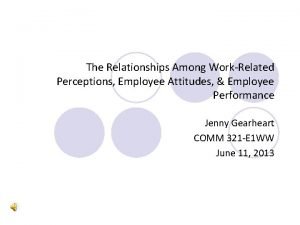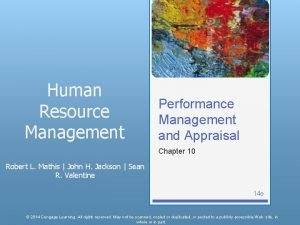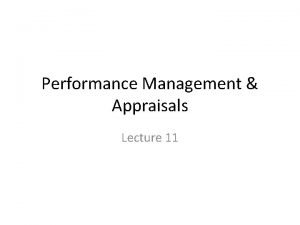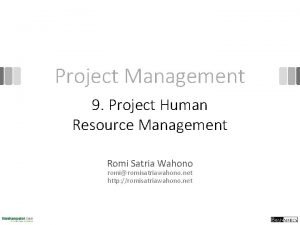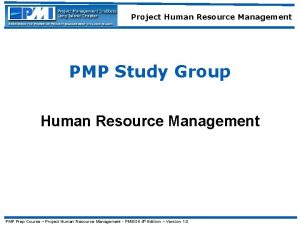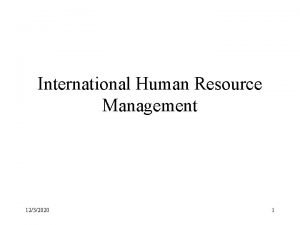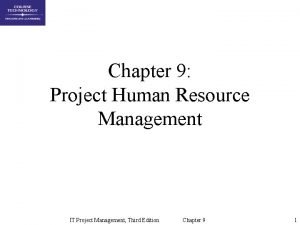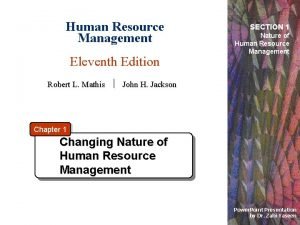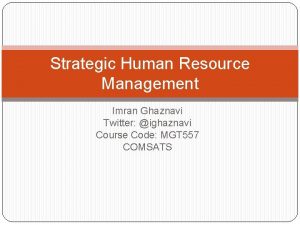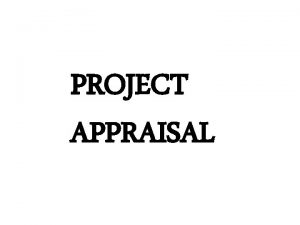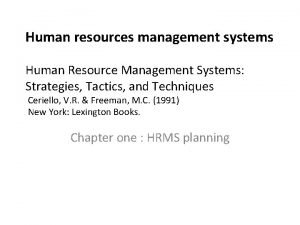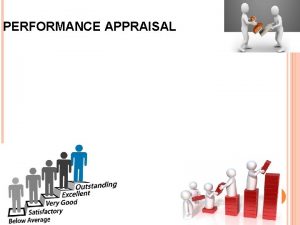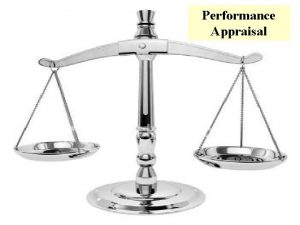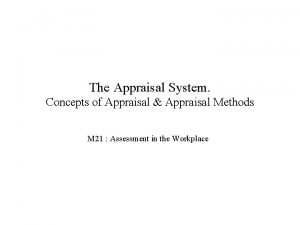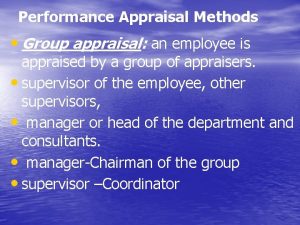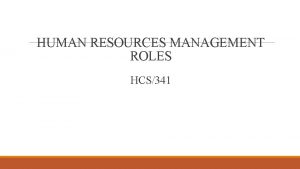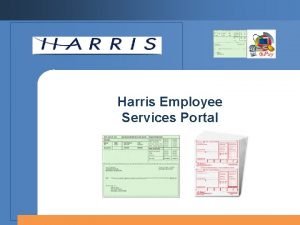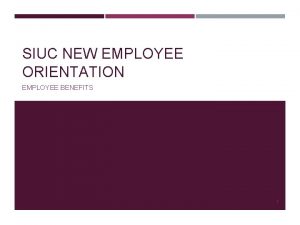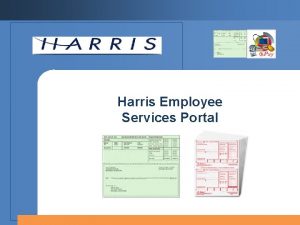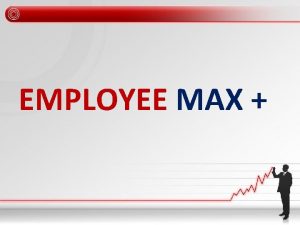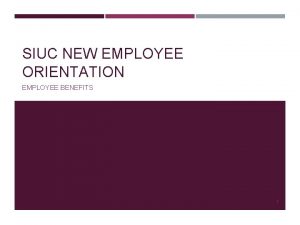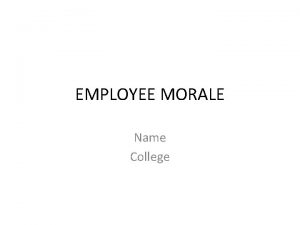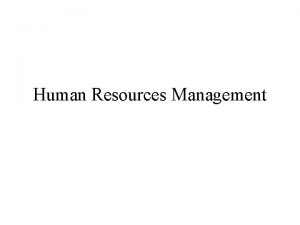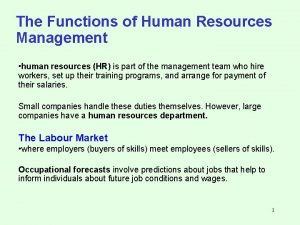Human Resources Management II Appraisal systems Employee Appraisal





















- Slides: 21

Human Resources Management II. Appraisal systems

Employee Appraisal – General Remarks • It is the most important activity in HRM (musceles and nerves of the system) • Basic tool in giving feedback to employees (wages, benefits, ch. in O. S. ) • Basic tool in collecting information for training, internal staffing, career management

Employee Appraisal – WHY I. ? • Differences in individual performance Ø blue-collar work (+ - 15% - average and best) Ø sales manager work (+ - 42% - average and best) Ø professionals work (+ - 46 % - average and best) - and we have to know who is who according to performance • Differences in trends of an employee performance Ø every company has to deal with „weak“ employees, yet without the appraisal system our possibilities are really limited Ø E. A. can improve and also make worse the atmosphere and motivation (feedback generally improves – so colled hit-and-miss flash-back generally demeans)

Employee Appraisal – WHY II. ? • Justice – almost everyone puts a stress on fairly-minded conditions – sence of justice is a very important force Ø depends on culture, yet in west Europe more than 96% of employees put a stress on fairly-minded conditions in a company. Ø Justice is value itself – even for HR managers (sometimes )

Employee Appraisal – The Process I. • Steps in Developing an Appraisal System Ø Determine Performance Requirements we should be aware of what is the core of employee work, and what skills, outputs or processes we are going to evaluate – we should know the job evaluation chart, or we should create job evaluation chart Examples: blue collar – number of TV-sets completed, manager – quality of work, cooperation with others employees, dependability Ø Choose an Appropriate Appraisal Method we have to choose a method or a set of methods which is appropriate - different groupes – different methods Examples: rating scales – operator, MBO – HR manager

Employee Appraisal – The Process II. • Steps in Developing an Appraisal System Ø Train Supervisors very critical step – supervisors must know what they do, must know why is A. P. important for a company and must be trained in fair rating – without well prepared supervisors the hole process is meaningless Ø Discuss Methods with Employees prior to the appraisal interview, supervisors and HRM should discuss with employees the method that will be used! E. should know what, why and how the A. P. goes.

Employee Appraisal – The Process III. • Steps in Developing an Appraisal System Ø Do the personnel rating (the A. P. itself) you do the process itself – the best strategy is to combine as many departments and jobs as possible together (exeptiones) Ø Discuss results with Employees everyone should know results, strong and weak points!, evolution of his own results and general evolution, how do you get the data and the interpretation – you should put a stress on positive part and on how to solve the weak points!

Employee Appraisal – The Process IV. • Steps in Developing an Appraisal System Ø Determine Future Performance Goals adjustment of goals (ac. to company, ac. to employee), adjustment of A. S. – in the beginning of the whole process it is inevitable Ø Save all data in timeline-save form the power of Appraisal system is based on the fact, that you do it as a repetition – without an information about how was the result in history – you know just a little bit about an employee! – therefore you need save your data and save them in a very specific formula

Common Appraisal Problems I. • To avoid appraisal problems means to know them ! Ø Supervisory Bias Ø the most common error – everyone likes and dislikes someone and supervisors are not exeptions (age, soccer team, sex), yet you should train them not to and you should explain why it is a deadly sin for supervisor Ø Halo effect Ø when you evaluate one particular aspect of an employee´s performance under the influence of evaluation of another aspect (good sales results do not mean good cooperation)

Common Appraisal Problems II. Ø Central Tendency Ø when you tend to put all employees together (find it difficult and unpleasant to evaluate some employees higher and some lower) or lack of objective evaluations Ø Leniency Ø problem of one kind of very good employee and inexperienced supervisors – generally put exellent marks to everyone (very dangerous!) Ø Strictness Ø Supervisor gives consistently low rating – opposite to leniency, yet also very dangerous

Common Appraisal Problems III. Ø Recency Ø what was the last time should be today also … it is also very dangerous mistake

Appraisal Methods I. • General remarks – there is no universal method, which we can use always! – ideally, an appraisal method is: objective, accurate, and easy to implement – ideal method (an sich) does not exist – we must seek compromise!

Appraisal Methods II. • Work standards Ø the first appraisal method, yet it importance decreaces (why? ) Ø clerical and manufacturing employees whose jobs are production or out-put focused Ø objective and usually very easy to perform, but for just one or two types of jobs Ø very few organizations use work standards as the sole performance-appraisal technique Ø fewer and fewer jobs can be measured solely by production level

Appraisal Methods III. • Rating Scales Ø with rating scales you can measure some cognitive standards, such as cooperation, loyalty or dependability (and other qualities) Ø rating scales are based on rating (usually graphical one) Ø first you should decide range of scale (no less then 3, no more then 12) – depends on number of employees and on objectivity of criterion Ø you may put comentary to the scale, but it is not used often (Rating Scales with comentary)

Appraisal Methods IV. • Ranking (simple and sophisticated comparison) Ø ranking employees form the most effective (or most communicative) to the least one Ø ranking is always comparative method – supervisor has to judge employees´performance in relation to each other instead of against standard! Ø general rating x specific rating (general can be more dangerous) Ø department ranking x job position ranking x company ranking Ø Advantages and disadvantages

Appraisal Methods V. • Forced Distribution Ø supervisor has to put every employee of his/her department in one of (for example) 5 lists – poor/below average/above average/excellet, yet to the poor he/she has to give just 2 employees! Ø forced distribution – more objective then simple ranking Ø people, and supervisors also dislike it

Appraisal Methods VI. • Paired Comparison Ø we know 2 types of Paired Comparison Ø the first one is based on everyone to everyone comparison (A -B comparison, A-C comparison, B-C comparison) and is more objective then simple ranking Ø the second one is based on so called „team appraisal“ – you do not evaluate persons, but teams – very good and used method

Appraisal Methods VII. • Critical Incidents Ø relatively modern performance-appraisal methods Ø the only thing you count is very positive and negative events Ø critical incidents can help, yet can not stand as a solitery appraisal method Ø very easy to use for supervisors (if they do not remember it means that it was not a critical incident)

Appraisal Methods VIII. • MBO Ø relatively modern performance-appraisal methods, yet only for some types of employees Ø management by objectives (MBO) is like writing a contract Ø HRM, department boss and employee discuss the goal of the employee work and set up criteria how to measure achievement of this goal Ø very good for managers, scientists (but be careful), and creative work

Appraisal System and Timeline • How often? Ø depends on what type of employee we would like to evaluate Ø managerial position – 3 months up to 1 year Ø labour worker - every day up to ½ year Ø scientist – 1 month to 3 years • What to do with results? Ø weak performance Ø excellent performance • How communicate results? Ø appraisal interview Ø system interviews

Appraisal System • You should set up appraisal system for: v sales department (5 sales managers) v which method or combination of methods v how often v impacts of results v supervisor v HR department (content) v small company (20 employees, content)
 Employee attitudes and employee performance
Employee attitudes and employee performance Performance appraisal in human resource management
Performance appraisal in human resource management Management fifteenth edition
Management fifteenth edition Swot analysis of performance management system
Swot analysis of performance management system Intrinsic rewards are psychic and self-granted
Intrinsic rewards are psychic and self-granted Graphic rating scale example
Graphic rating scale example Human resource histogram
Human resource histogram What are physical resources
What are physical resources Human resource and job design in operations management
Human resource and job design in operations management The importance of hrm
The importance of hrm Empower human resources
Empower human resources What is hrm
What is hrm Chapter 9 human resources management
Chapter 9 human resources management Human resource management final exam pdf
Human resource management final exam pdf Organizational chart for retail business
Organizational chart for retail business Intro to human resource management
Intro to human resource management Management science ovgu
Management science ovgu Human resources management gaining a competitive advantage
Human resources management gaining a competitive advantage Chapter 9 human resources management
Chapter 9 human resources management Nature of hrm
Nature of hrm Time management in human resource management
Time management in human resource management Explain the concept of hrm
Explain the concept of hrm
